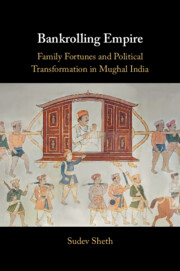Book contents
- Bankrolling Empire
- Bankrolling Empire
- Copyright page
- Dedication
- Contents
- Figures
- Maps
- Tables
- A Note on Translations, Transliterations, and Dates
- Acknowledgments
- Mughal Family Tree
- Jhaveri Family Tree
- Gaekwad Family Tree
- Haribhakti Family Tree
- Introduction
- 1 Prelude: The Mughal Empire, 1526–1750
- 2 Courtly Mutualism: The Emperor’s Jeweler Shantidas Jhaveri, 1628–58
- 3 Political Commensalism: Manekchand Jhaveri and Bankrolling Bids to the Throne, 1658–1707
- 4 Interlude: Cultivating Financial Crisis under Aurangzeb, 1660s–1719
- 5 Expedient Extortion: The Governor’s Golden Goose Khushalchand Jhaveri, 1719–30
- 6 Competitive Coparcenary: Vakhatchand Jhaveri and Brokering Politics, 1730–1818
- 7 Postlude: Bankrollers of Mughal Succession, 1750–1818
- Conclusion
- Book part
- Glossary
- Bibliography
- Index
4 - Interlude: Cultivating Financial Crisis under Aurangzeb, 1660s–1719
Published online by Cambridge University Press: 16 November 2023
- Bankrolling Empire
- Bankrolling Empire
- Copyright page
- Dedication
- Contents
- Figures
- Maps
- Tables
- A Note on Translations, Transliterations, and Dates
- Acknowledgments
- Mughal Family Tree
- Jhaveri Family Tree
- Gaekwad Family Tree
- Haribhakti Family Tree
- Introduction
- 1 Prelude: The Mughal Empire, 1526–1750
- 2 Courtly Mutualism: The Emperor’s Jeweler Shantidas Jhaveri, 1628–58
- 3 Political Commensalism: Manekchand Jhaveri and Bankrolling Bids to the Throne, 1658–1707
- 4 Interlude: Cultivating Financial Crisis under Aurangzeb, 1660s–1719
- 5 Expedient Extortion: The Governor’s Golden Goose Khushalchand Jhaveri, 1719–30
- 6 Competitive Coparcenary: Vakhatchand Jhaveri and Brokering Politics, 1730–1818
- 7 Postlude: Bankrollers of Mughal Succession, 1750–1818
- Conclusion
- Book part
- Glossary
- Bibliography
- Index
Summary
Taking a pause from direct focus on the Jhaveris, Chapter 4 is an interlude that outlines major shifts across the Mughal Empire between the 1680 and 1720s. I suggest that military campaigns in the Deccan region impinged the Mughal treasury and undermined administration to an extent never seen before. Officials in Gujarat started to engage in behavior that undermined Mughal sovereignty. Yet, they also had little choice as monetary resources were becoming scarce. Financial limitations impacted the quality of state machinery including the upkeep of buildings, delay in salary payments, and even the ability of officials to legitimately demand taxes. Despite this, local Gujarati poems suggest that residents preferred Mughal rule to ruthless attacks from the Maratha marauders, whose periodic raids were increasing in frequency and intensity. After Aurangzeb’s death in 1707, successive Mughal emperors were poorly equipped to revive the grandeur of their ancestors. Their short stints as emperors, sometimes as brief as a few months, led to the further breakdown of Mughal authority. This manifest most clearly in the form of rivalries between Mughal governors sent to control and profit from Gujarat. Insecure in their positions and strapped for cash, these governors turned to assaulting key members of the business fraternity in the city of Ahmedabad.
Keywords
- Type
- Chapter
- Information
- Bankrolling EmpireFamily Fortunes and Political Transformation in Mughal India, pp. 136 - 176Publisher: Cambridge University PressPrint publication year: 2023

